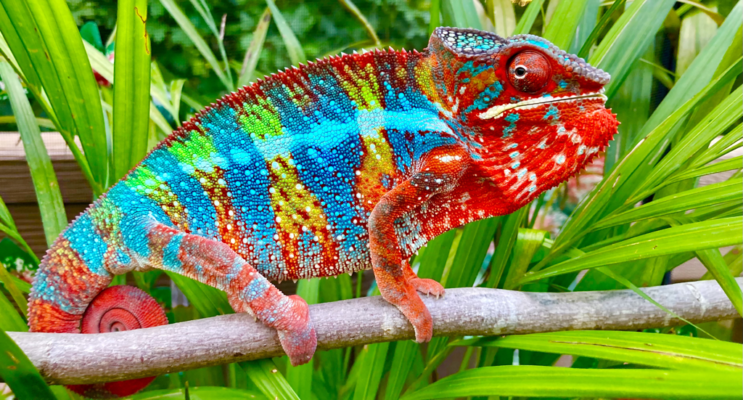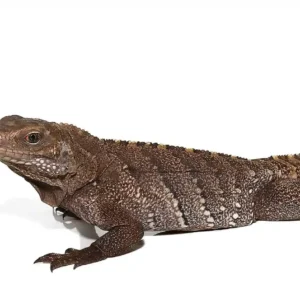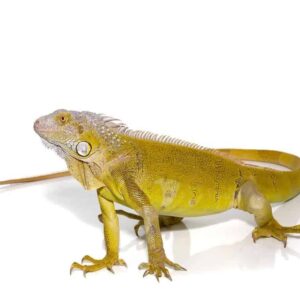Ambilobe Panther Chameleon For Sale
$299.99
WE HAVE AMBILOBE PANTHER CHAMELEON FOR SALE. HERE ARE SOME HIGHLIGHTS:
- Furcifer pardalis
- Captive Bred
- Approximate Sizes Ranging From 9 – 12 Inches Length
- Adults Are Averaging Around 12 – 18 Inches In Total Length
- Feeding On Vitamin Dusted Crickets, Worms And Roaches
FUN FACTS!!
- This Is One Of The Most Popular Species Of Chameleons Due To Their Extreme Coloration
- Male Chameleons Display More Vibrant Colors Than Females
- Originating From Madagascar These Range From The Coastal Central To Northeastern Madagascar
- Arboreal Species, Provide Plenty Of Fake Plants And Branches
- A Misting Or Dripping System For Water Is Best, Manual Misting Also Works
- With Proper Care They Can Live Up To 3 – 5 Years In Captivity
Description
Ambilobe Panther Chameleon
The Ambilobe Panther Chameleon, a subspecies of the panther chameleon (Furcifer pardalis), is renowned for its vivid and striking color variations. Native to the Ambilobe region in Madagascar, these chameleons are a popular choice among reptile enthusiasts due to their stunning appearance and relatively manageable care requirements.
One of the most captivating features of the Ambilobe Panther Chameleon is its vibrant coloration. Males typically exhibit a breathtaking array of colors, including bright blues, reds, oranges, and greens. These colors can change depending on various factors such as mood, temperature, and light, making them a dynamic and visually appealing species. Females, while more subdued in color, often display attractive pastel hues of pink, peach, and light green.
In addition to their color variations, the Ambilobe Panther Chameleon possesses other distinctive physical characteristics. They have a laterally compressed body, a prehensile tail used for gripping branches, and independently mobile eyes that provide a wide field of vision. These adaptations make them highly adept at navigating their arboreal habitats and spotting prey from a distance.
Chameleons, in general, are known for their unique ability to change color, but the Ambilobe Panther Chameleon stands out due to the intensity and variety of its hues. This trait, combined with their relatively docile nature, makes them a favorite among reptile keepers and breeders. Their popularity is also bolstered by the fact that they can be bred in captivity, which helps to reduce the pressure on wild populations.
Overall, the Ambilobe Panther Chameleon is an extraordinary example of nature’s artistry, offering a captivating glimpse into the diversity of life found in Madagascar. Their striking appearance and fascinating behaviors continue to enthrall both novice and experienced reptile enthusiasts alike.
The Ambilobe Panther Chameleon (Furcifer pardalis) thrives in the unique and diverse ecosystem of the Ambilobe region in northern Madagascar. This area is characterized by a tropical climate, with distinct wet and dry seasons. The region boasts lush, dense forests and is interlaced with rivers and streams, providing the ideal environment for these vibrant reptiles. The dense vegetation, including an array of trees, shrubs, and low-lying plants, offers ample opportunities for the chameleons to camouflage and hunt for insects, which constitute the majority of their diet.
The climate in Ambilobe is typically warm and humid, with temperatures ranging from 20°C to 30°C (68°F to 86°F) and high humidity levels, particularly during the wet season. This tropical climate is crucial for the Ambilobe Panther Chameleon’s hydration and thermoregulation. The chameleons are adept climbers, using their prehensile tails and zygodactylous feet to navigate the complex terrain of branches and foliage. These physiological adaptations are critical for their survival, aiding in predator evasion and efficient foraging.
The geographic features of the Ambilobe region also play a pivotal role in the chameleons’ behavior. The varied elevation, from lowland forests to mountainous areas, provides diverse microhabitats. These varying conditions influence the chameleons’ coloration and patterns, which are not only a defense mechanism but also play a role in communication and mate attraction. The vibrant hues of the Ambilobe Panther Chameleon are a testament to the rich biodiversity and specific environmental conditions of their natural habitat.
Despite the resilience of the Ambilobe Panther Chameleon, their habitat faces significant threats from deforestation, agricultural expansion, and climate change. These environmental pressures have led to habitat fragmentation, which poses a risk to their populations. Conservation efforts are underway to preserve the natural forests of Madagascar, with various organizations working to promote sustainable practices and habitat restoration. These initiatives are essential to safeguard the future of the Ambilobe Panther Chameleon and the intricate ecosystem they inhabit.
Physical Characteristics and Color Morphs
The Ambilobe Panther Chameleon, a subspecies of the Panther Chameleon, is notable for its vibrant and diverse coloration, which makes it a popular choice among reptile enthusiasts. Typically, an adult Ambilobe Panther Chameleon measures between 14 to 20 inches in length, with males generally being larger than females. One of the distinguishing physical characteristics of this chameleon is its casque, a helmet-like structure on top of its head, which serves both as a display feature and a means of channeling water towards its mouth.
Another unique trait of the Ambilobe Panther Chameleon is its prehensile tail, which is adept at grasping branches and aiding in balance. This tail, along with their zygodactylous feet — two toes facing forward and two backward — enables them to navigate their arboreal habitats with agility and precision.
The coloration of the Ambilobe Panther Chameleon is where its true magnificence lies. These chameleons exhibit a wide array of color morphs, ranging from vibrant reds and blues to striking greens and yellows. The specific color morphs are often geographically influenced, with distinct patterns and hues associated with different locales within their native range in Madagascar. For instance, chameleons from the northern parts of Ambilobe tend to display more vivid red and blue combinations, while those from the southern regions may exhibit a predominance of green and yellow hues.
Various factors can influence the color changes in Ambilobe Panther Chameleons. Mood is a significant factor; a chameleon may brighten its colors when feeling threatened or to attract a mate. Temperature also plays a crucial role, with cooler temperatures often resulting in darker hues as the chameleon attempts to absorb more heat. Additionally, lighting conditions can affect the visibility and intensity of their colors, with natural sunlight generally enhancing their vibrancy compared to artificial lighting.
Understanding these physical characteristics and color morphs is essential for anyone interested in keeping Ambilobe Panther Chameleons as pets or studying them in their natural habitat. Their remarkable adaptability and stunning appearance make them a fascinating subject for herpetology enthusiasts and researchers alike.
Diet and Nutrition
The Ambilobe Panther Chameleon, an exquisite and vibrant reptile, thrives on an insectivorous diet. Primarily, their nutritional intake consists of a variety of insects, with crickets, roaches, and worms being their staple food sources. Crickets are highly favored due to their availability and nutritional profile, offering essential proteins and vitamins. Dubia roaches provide a more substantial meal, rich in protein and low in chitin, making them easier to digest. Worms, such as superworms and silkworms, are also integral, adding diversity and additional nutrients to their diet.
To ensure optimal health, gut-loading the insects before feeding them to the Ambilobe Panther Chameleon is crucial. Gut-loading involves feeding the insects nutritious foods, such as leafy greens, fruits, and specialized gut-load formulas, 24 to 48 hours before they are offered to the chameleon. This process enriches the nutritional value of the insects, ensuring that the chameleon receives a balanced and nutrient-rich diet.
Supplementation is another key aspect of the Ambilobe Panther Chameleon’s diet. Calcium and vitamin supplements are vital to prevent deficiencies and support overall health. Calcium should be dusted on the insects at least three times a week, while a multivitamin supplement should be provided once a week. For younger chameleons, more frequent supplementation might be necessary to support their rapid growth and development.
Feeding frequency varies based on the age and health status of the chameleon. Juvenile Ambilobe Panther Chameleons require daily feedings due to their high metabolic rates and growth demands. Adults, on the other hand, can be fed every other day, as their growth rate slows down and they require fewer calories. Monitoring the chameleon’s weight and overall health can help in adjusting the feeding schedule and quantities accordingly.
In summary, providing a varied and nutritious diet, along with proper gut-loading and supplementation, is essential for maintaining the health and vibrancy of the Ambilobe Panther Chameleon. Consistent attention to their dietary needs will ensure they thrive in captivity, showcasing their stunning colors and active behaviors.
Housing and Enclosure Requirements
Creating an optimal enclosure for the Ambilobe Panther Chameleon is crucial for its health and well-being. An appropriately sized and well-ventilated habitat replicates the chameleon’s natural environment, ensuring it thrives in captivity. The enclosure should be vertically oriented, as these arboreal reptiles prefer to climb. A minimum size of 24″x24″x48″ is recommended for an adult chameleon. Mesh or screen enclosures are ideal for maintaining proper air circulation, which is vital for preventing respiratory issues.
Temperature gradients within the enclosure are essential for thermoregulation. The ambient temperature should range between 75°F to 85°F, with a basking spot reaching up to 90°F-95°F. Utilize a combination of heat lamps and UVB lighting to simulate sunlight, ensuring the chameleon receives adequate heat and ultraviolet rays necessary for calcium metabolism. Nighttime temperatures can safely drop to around 65°F to 70°F to mimic the natural drop in temperature.
Maintaining proper humidity levels is another critical aspect of housing Ambilobe Panther Chameleons. Ideal humidity should be between 50% and 70%. Regular misting, either manually or with an automated misting system, helps achieve these levels. Additionally, providing a drip system or a water bowl can encourage hydration through drinking.
The choice of substrate can significantly impact the enclosure’s microclimate. Opt for substrates that retain moisture yet allow proper drainage, such as coconut fiber or soil mixes. Avoid using substrates that can be ingested and cause impaction, such as sand or gravel.
Furnishing the enclosure to mimic the chameleon’s natural habitat is essential for its mental and physical well-being. Provide a variety of branches and vines at different heights to facilitate climbing and exploration. Live plants, such as pothos or ficus, not only enhance the aesthetic appeal but also contribute to humidity regulation and offer hiding spots. Additionally, ensure there are ample leaf cover and hiding spots to make the chameleon feel secure.
By paying close attention to these housing and enclosure requirements, you can create a habitat that closely resembles the Ambilobe Panther Chameleon’s natural environment, promoting a healthy and stress-free life for your reptilian companion.
Health and Common Issues
Ambilobe Panther Chameleons are captivating creatures that require meticulous care to ensure their health and well-being. Like all reptiles, they are susceptible to various health issues, with some of the most common being metabolic bone disease (MBD), respiratory infections, and parasitic infestations. Understanding these potential problems and knowing how to prevent them is crucial for any chameleon owner.
Metabolic bone disease is a prevalent condition among chameleons, often resulting from a deficiency in calcium or improper calcium to phosphorus ratios in their diet. Symptoms of MBD include lethargy, swollen limbs, and an inability to climb properly. To prevent MBD, it is essential to provide a balanced diet rich in calcium and ensure proper UVB lighting to facilitate calcium absorption.
Respiratory infections are another significant concern for Ambilobe Panther Chameleons, typically caused by inadequate humidity levels or poor ventilation within their enclosure. Signs of respiratory infections include wheezing, gasping, and nasal discharge. Maintaining optimal humidity levels and ensuring proper air circulation can help prevent these infections. If symptoms persist, seeking veterinary care is imperative to avoid severe complications.
Parasitic infestations, both internal and external, can also pose a threat to these chameleons. Internal parasites often lead to weight loss, diarrhea, and a general decline in health, while external parasites, such as mites, cause skin irritation and stress. Regular fecal examinations and maintaining a clean habitat can help detect and prevent parasitic issues. Should an infestation occur, veterinary intervention is necessary to prescribe appropriate treatments.
Regular veterinary check-ups play a vital role in the early detection and prevention of these health issues. Observing your chameleon for any signs of illness, such as changes in appetite, behavior, or physical appearance, is crucial. Basic first-aid measures, like isolating the affected chameleon and maintaining optimal husbandry conditions, can provide initial relief while seeking professional care.
In conclusion, ensuring the health of Ambilobe Panther Chameleons involves a combination of proper diet, optimal environmental conditions, and regular veterinary care. By being vigilant and proactive, owners can significantly reduce the risk of health issues and ensure their chameleons lead healthy, vibrant lives.
Breeding and Reproduction
The breeding behavior and reproductive cycle of the Ambilobe Panther Chameleon are intricate and fascinating. To begin, identifying the sex of these chameleons is crucial. Males typically display more vibrant colors and possess a hemipenal bulge at the base of the tail, while females are generally smaller and exhibit less vivid coloration. Creating a suitable breeding environment involves ensuring an optimal habitat that mimics their natural conditions, including appropriate temperature gradients, humidity levels, and ample foliage for climbing and hiding.
Mating usually occurs during the warmer months when females become receptive, signaled by a change in coloration. The male initiates the courtship with his vibrant display of colors and physical gestures. Once the female accepts the male’s advances, copulation occurs and can last several minutes. Post-mating, the female will require increased calcium intake and a nutrient-rich diet to support egg development.
Approximately 20 to 30 days after mating, the female will lay her eggs. It is essential to provide a suitable laying bin filled with a moist substrate, such as a mixture of sand and soil, to encourage her to dig and lay her eggs. The clutch size can vary, typically ranging from 10 to 40 eggs. Once the eggs are laid, they should be carefully transferred to an incubation container with a vermiculite substrate, maintaining a stable temperature of around 26-28°C (78-82°F) and consistent humidity levels.
Incubation spans approximately six to nine months, after which the eggs will begin to hatch. Hatchlings are delicate and require a controlled environment with appropriate temperature, humidity, and UVB lighting. Their diet should consist of small, appropriately-sized insects dusted with calcium and vitamin supplements. It is also vital to monitor their growth and health closely.
Ethical considerations in breeding Ambilobe Panther Chameleons include avoiding overbreeding, ensuring genetic diversity, and adhering to responsible breeding practices. This includes providing proper care and habitat for both breeding adults and hatchlings, and only breeding healthy, genetically diverse chameleons to prevent potential health issues.
Tips for New Owners
Embarking on the journey of owning an Ambilobe Panther Chameleon is both exciting and rewarding. However, it requires careful preparation and ongoing commitment to ensure the health and well-being of your new reptilian companion. Here are some essential tips for new owners to consider.
Firstly, choosing a healthy specimen is paramount. Look for chameleons that exhibit bright, vibrant colors and active behavior. Avoid individuals that appear lethargic, have sunken eyes, or display signs of respiratory issues such as wheezing or excessive mucus. Reputable breeders or pet stores with good reviews are often the best sources for acquiring a healthy Ambilobe Panther Chameleon.
Setting up the enclosure properly is the next crucial step. Ambilobe Panther Chameleons require a vertical, well-ventilated habitat with plenty of climbing opportunities. A screen cage with dimensions of at least 24″ x 24″ x 48″ is recommended. Ensure the enclosure mimics their natural environment with live plants, branches, and vines. Proper lighting, including UVB and basking lights, is essential for their health. Maintain a temperature gradient, with a basking spot around 85-90°F and a cooler area at 70-75°F. Humidity levels should be kept between 60-80%, achievable through regular misting and a well-maintained hydration system.
Establishing a routine care schedule is vital. Daily tasks include feeding, misting, and monitoring the chameleon’s health. Offer a varied diet of gut-loaded insects such as crickets, roaches, and occasional treats like silkworms. Dust the insects with calcium and vitamin supplements to prevent nutritional deficiencies. Clean the enclosure regularly to maintain a healthy environment and reduce the risk of infections.
Research and preparation before acquiring a chameleon cannot be overstated. Familiarize yourself with their specific needs and behaviors. Join online forums and chameleon care communities for support and advice from experienced owners. These platforms offer a wealth of knowledge, from troubleshooting health issues to optimizing habitat conditions.
In summary, owning an Ambilobe Panther Chameleon demands dedication and continuous learning. By adhering to these tips and leveraging available resources, new owners can ensure a thriving and enriching experience for both themselves and their chameleons.






